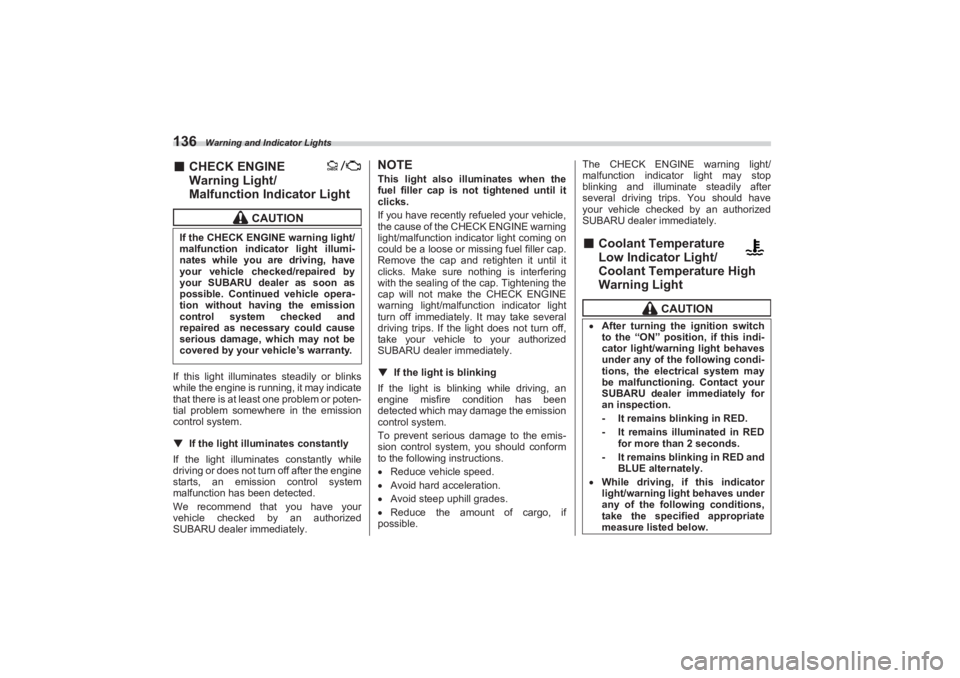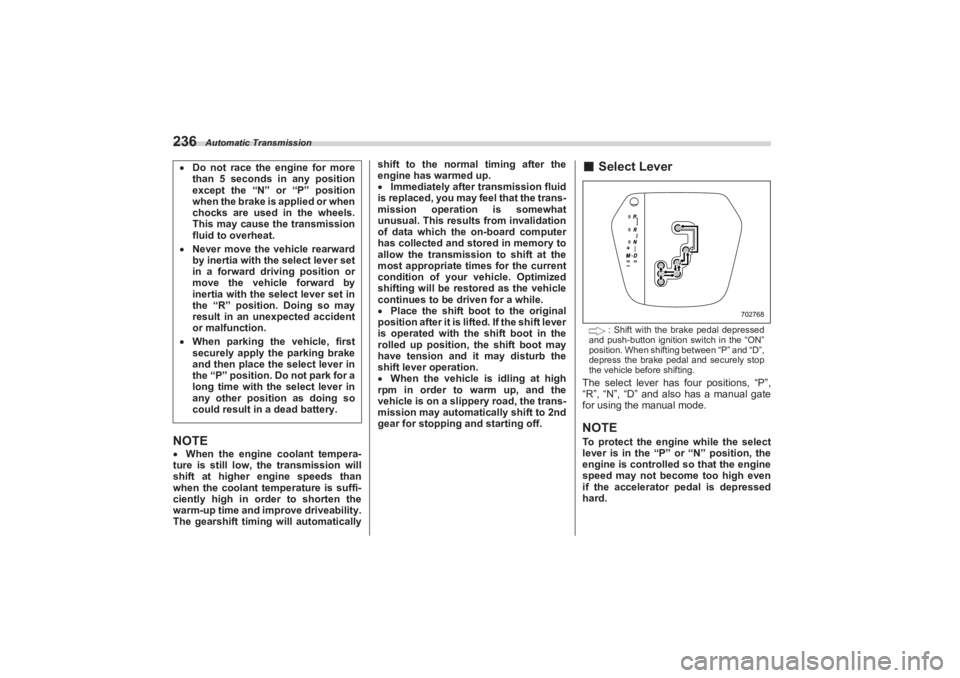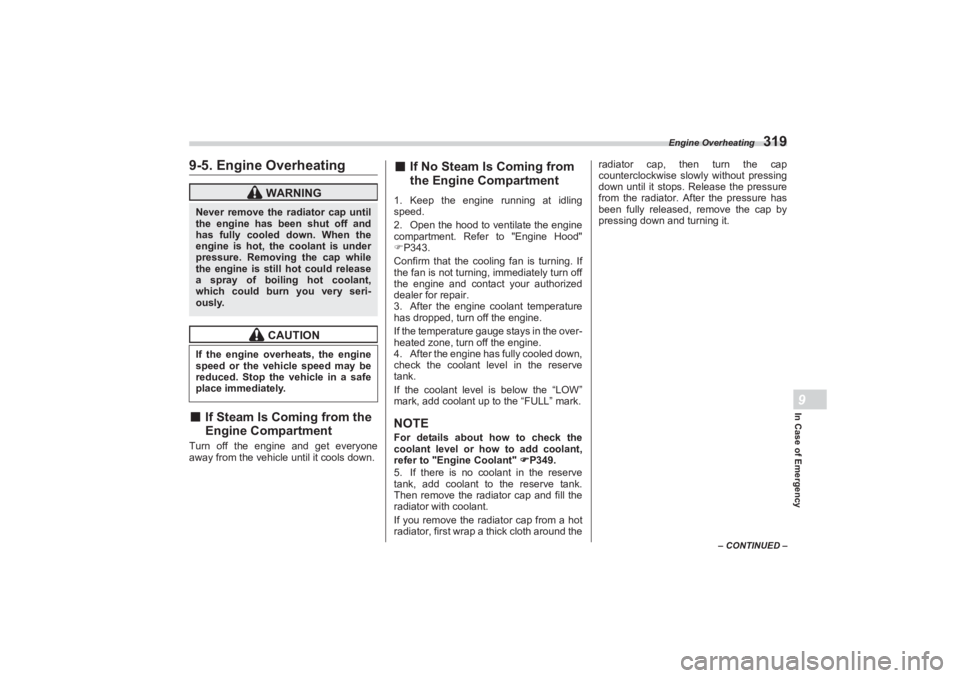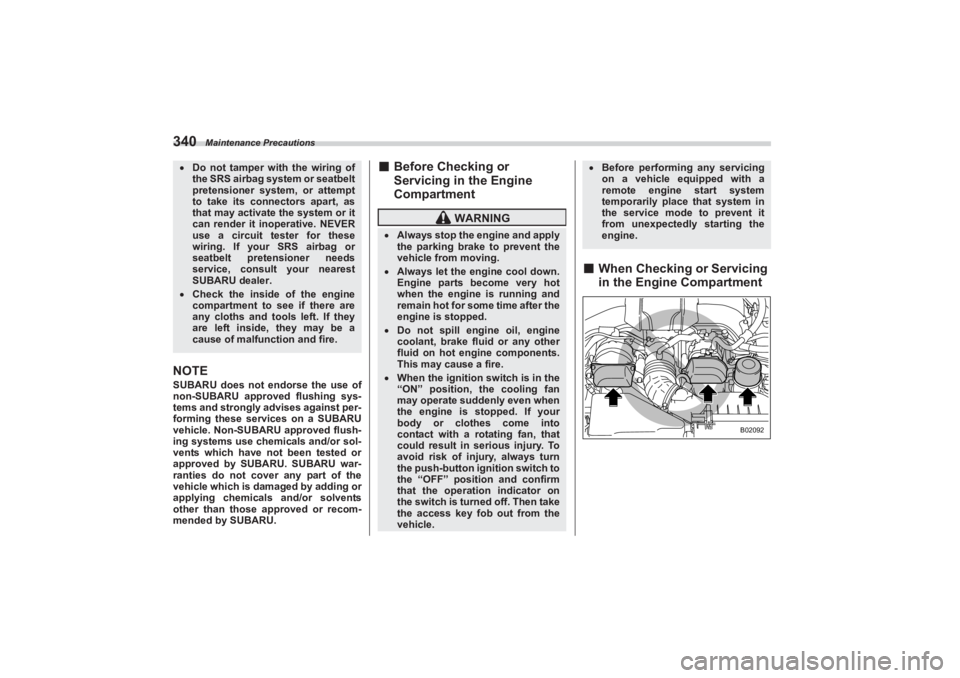2023 SUBARU BRZ engine coolant
[x] Cancel search: engine coolantPage 142 of 432

Warning and Indicator Lights
136■CHECK ENGINE
Warning Light/
Malfunction Indicator LightIf this light illuminates steadily or blinks
while the engine is running, it may indicate
that there is at least one problem or poten-
tial problem somewhere in the emission
control system.
▼ If the light illuminates constantly
If the light illuminates constantly while
driving or does not turn off after the engine
starts, an emission control system
malfunction has been detected.
We recommend that you have your
vehicle checked by an authorized
SUBARU dealer immediately.
NOTEThis light also illuminates when the
fuel filler cap is not tightened until it
clicks.
If you have recently refueled your vehicle,
the cause of the CHECK ENGINE warning
light/malfunction indicator light coming on
could be a loose or missing fuel filler cap.
Remove the cap and retighten it until it
clicks. Make sure not hing is interfering
with the sealing of the cap. Tightening the
cap will not make the CHECK ENGINE
warning light/malfunction indicator light
turn off immediately. It may take several
driving trips. If the light does not turn off,
take your vehicle to your authorized
SUBARU dealer immediately.
▼ If the light is blinking
If the light is blinking while driving, an
engine misfire condition has been
detected which may damage the emission
control system.
To prevent serious damage to the emis-
sion control system, you should conform
to the following instructions.
Reduce vehicle speed.
Avoid hard acceleration.
Avoid steep uphill grades.
Reduce the amount of cargo, if
possible. The CHECK ENGINE warning light/
malfunction indicator light may stop
blinking and illuminate steadily after
several driving trips. You should have
your vehicle checked by an authorized
SUBARU dealer immediately.
■ Coolant Temperature
Low Indicator Light/
Coolant Temperature High
Warning Light
CAUTION
If the CHECK ENGINE warning light/
malfunction indicator light illumi-
nates while you are driving, have
your vehicle checked/repaired by
your SUBARU dealer as soon as
possible. Continued vehicle opera-
tion without havi ng the emission
control system checked and
repaired as necessary could cause
serious damage, which may not be
covered by your vehicle’s warranty.
CAUTION
After turnin g the ignition switch
to the “ON” position, if this indi-
cator light/warnin g light behaves
under any of the following condi-
tions, the electrical system may
be malfunctioning. Contact your
SUBARU dealer immediately for
an inspection.
- It remains blinking in RED.- It remains illuminated in RED for more than 2 seconds.- It remains blinking in RED and
BLUE alternately.
While driving, if this indicator
light/warning light behaves under
any of the following conditions,
take the specified appropriate
measure listed below.
BRZ_U.book 136 ページ 2022年3月29日 火曜日 午後3時59分
Page 143 of 432

Warning and Indicator Lights
137
Instruments and Controls3
– CONTINUED –
This coolant temperature low indicator
light/coolant temper ature high warning
light has the following three functions.
Illumination in BLUE indicates insuffi-
cient warming up of the engine
Blinking in RED indicates that the
engine is close to overheating
Illumination in RED indicates over-
heating condition of the engine
For the system check, this indicator light/
warning light illuminates in RED for
approximately 2 seconds when the igni-
tion switch is turned to the “ON” position.
After that, this indicator light/warning light
changes to BLUE and maintains illumina- tion in
BLUE. This BLUE illuminated light
turns off when the engine is warmed up
sufficiently.
If the engine coolant temperature
increases over the specified range, the
indicator light/warning light blinks in RED.
At this time, the engine is close to over-
heating.
If the engine coolant temperature
increases further, the indicator light/
warning light illuminates in RED continu-
ously. At this time, the engine may be
overheating.
When the indicator light/warning light
blinks in RED or illuminates in RED, safely
stop the vehicle as soon as possible, and
refer to the emergency steps for the
engine overheating. Refer to "Engine
Overheating" P319. After that, have the
system checked by your nearest
SUBARU dealer.
Also, if the indicator light/warning light
often blinks in RED, the electrical system
may be malfunctioning. Contact your
SUBARU dealer for an inspection.
NOTEIf the engine is restarted after a certain
driving condition, this indicator light/
warning light may illuminate in RED.
However, this is not a malfunction if the indicator light/warning light turns
off after a short time.
■ Charge Warning LightIf this light illuminates when the engine is
running, it may indicate that the charging
system is not working properly.
If the light illuminates while driving or does
not turn off after the engine starts, stop the
engine at the first safe opportunity and
check the drive belt. If the belt is loose,
broken or if the belt is in good condition
but the light remains illuminated, contact
your nearest SUBARU dealer immedi-
ately.■ Oil Pressure Warning
LightIf this light illuminates when the engine is
running, it may indicate that the engine oil
pressure is low and the lubricating system
is not working properly.
If the light illuminates while driving or does
not turn off after the engine starts, stop the
- Blinking or illuminated in
RED:
Safely stop the vehicle as
soon as possible, and refer to
the emergency steps for the
engine overheating. After that,
have the system checked by
your nearest SUBARU dealer.
Refer to "Engine Overheating"
P319- Blinking in RED and BLUE
alternately:
The electrical system may be
malfunctioning. Contact your
SUBARU dealer for an inspec-
tion.
CAUTION
Do not operate the engine with the
oil pressure warning light on. This
may cause serious engine damage.
BRZ_U.book 137 ページ 2022年3月29日 火曜日 午後3時59分
Page 235 of 432

Starting and Stopping Engine
229
Starting and Operating7
– CONTINUED –
NOTEEngine oil, engine coolant, brake fluid,
washer fluid and other fluid levels
should be checked daily, weekly or at
fuel stops.
7-4. Starting and Stopping Engine■Safety PrecautionsRefer to "Safety Precautions" P94.■Operating Range for Push-
Button Start SystemRefer to "Operating Range for Push-
Button Start System" P125.■ General Precautions When
Starting Engine
NOTEIt may be difficult to start the engine
when the battery has been discon-
nected and reconnected (for mainte-
nance or other purposes). This
difficulty is caused by the electroni-
cally controlled throttle’s self-diag-
nosis function. To overcome it, keep
the ignition switch in the “ON” position
for approximately 10 seconds before
starting the engine.
Avoid rapid racing and rapid accel-
eration immediately after the engine
has started.
After the engine starts, the engine
speed will be kept high.
CAUTION
Small animals trapped in the cool-
ing fan and belt of the engine may
result in a malfunction. Check that
no small animal enters the engine
compartment and under the vehicle
before starting the engine.
WARNING
Never start the engine from
outside the vehicle. It may result
in an accident. Do not leave the engine running
in locations with poor ventilation,
such as a garage and indoors.
The exhaust gas may enter the
vehicle or indoors, and it may
result in carbon monoxide
poisoning.
Do not start the engine near dry
foliage, paper, or other flammable
substances. The exhaust pipe
and exhaust emissions can
create a fire hazard at high
temperatures.
CAUTION
If the engine is stopped during
driving, the catalyst may overheat
and burn. When starting the engine, be sure
to sit in the driver’s seat.
BRZ_U.book 229 ページ 2022年3月29日 火曜日 午後3時59分
Page 242 of 432

Automatic Transmission
236NOTEWhen the engine coolant tempera-
ture is still low, the transmission will
shift at higher engine speeds than
when the coolant temperature is suffi-
ciently high in order to shorten the
warm-up time and improve driveability.
The gearshift timing will automatically shift to the normal
timing after the
engine has warmed up.
Immediately after transmission fluid
is replaced, you may feel that the trans-
mission operation is somewhat
unusual. This results from invalidation
of data which the on-board computer
has collected and stored in memory to
allow the transmission to shift at the
most appropriate times for the current
condition of your vehicle. Optimized
shifting will be restored as the vehicle
continues to be driven for a while.
Place the shift boot to the original
position after it is lifted. If the shift lever
is operated with the shift boot in the
rolled up position, the shift boot may
have tension and it may disturb the
shift lever operation.
When the vehicle is idling at high
rpm in order to warm up, and the
vehicle is on a slippery road, the trans-
mission may automatically shift to 2nd
gear for stopping and starting off.
■ Select Lever
: Shift with the brake pedal depressed
and push-button ignition switch in the “ON”
position. When shifting between “P” and “D”,
depress the brake pedal and securely stop
the vehicle before shifting.
The select lever has four positions, “P”,
“R”, “N”, “D” and also has a manual gate
for using the manual mode.NOTETo protect the engine while the select
lever is in the “P” or “N” position, the
engine is controlled so that the engine
speed may not become too high even
if the accelerator pedal is depressed
hard.
Do not race the engine for more
than 5 seconds in any position
except the “N” or “P” position
when the brake is applied or when
chocks are used in the wheels.
This may cause the transmission
fluid to overheat. Never move the vehicle rearward
by inertia with the select lever set
in a forward driving position or
move the vehicle forward by
inertia with the select lever set in
the “R” position. Doing so may
result in an unexpected accident
or malfunction. When parking the vehicle, first
securely apply the parking brake
and then place the select lever in
the “P” position. Do not park for a
long time with the select lever in
any other position as doing so
could result in a dead battery.
702768
BRZ_U.book 236 ページ 2022年3月29日 火曜日 午後3時59分
Page 325 of 432

Engine Overheating
319
In Case of Emergency9
– CONTINUED –
9-5. Engine Overheating■If Steam Is Coming from the
Engine CompartmentTurn off the engine and get everyone
away from the vehicle until it cools down.
■ If No Steam Is Coming from
the Engine Compartment1. Keep the engine running at idling
speed.
2. Open the hood to ventilate the engine
compartment. Refer to "Engine Hood"
P343.
Confirm that the cooling fan is turning. If
the fan is not turning, immediately turn off
the engine and contact your authorized
dealer for repair.
3. After the engine coolant temperature
has dropped, turn off the engine.
If the temperature gauge stays in the over-
heated zone, turn off the engine.
4. After the engine has fully cooled down,
check the coolant level in the reserve
tank.
If the coolant level is below the “LOW”
mark, add coolant up to the “FULL” mark.NOTEFor details about how to check the
coolant level or how to add coolant,
refer to "Eng ine Coolant" P349.
5. If there is no coolant in the reserve
tank, add coolant to the reserve tank.
Then remove the radiator cap and fill the
radiator with coolant.
If you remove the radiator cap from a hot
radiator, first wrap a thick cloth around the radiator cap, then turn the cap
counterclockwise slowly without pressing
down until it stops. Release the pressure
from the radiator. After the pressure has
been fully released, remove the cap by
pressing down and turning it.
WARNING
Never remove the radiator cap until
the engine has been shut off and
has fully cooled down. When the
engine is hot, the coolant is under
pressure. Removing the cap while
the engine is still hot could release
a spray of boiling hot coolant,
which could burn you very seri-
ously.
CAUTION
If the engine overheats, the engine
speed or the vehicle speed may be
reduced. Stop the vehicle in a safe
place immediately.
BRZ_U.book 319 ページ 2022年3月29日 火曜日 午後3時59分
Page 343 of 432

Maintenance and Service11
Maintenance and Service
11-1. Maintenance Schedule .....................................339
11-2. Maintenance Precautions.................................339
Before Checking or Servicing in the Engine
Compartment ..............................................................340
When Checking or Servicing in the Engine Compartment ..............................................................340
When Checking or Servicing in the Engine Compartment While the Engine Is Running ............341
11-3. Maintenance Tips ..............................................341
Removing and Reinstalling Clips................................341
11-4. Engine Hood ......................................................343
11-5. Engine Compartment Overview.......................345
11-6. Engine Oil ..........................................................346
Engine Oil Consumption..............................................346
Checking the Oil Level .................................................346
Changing the Oil and Oil Filter ....................................347
Recommended Grade and Viscosity ..........................347
Synthetic Oil..................................................................348
11-7. Cooling System .................................................348
Cooling Fan, Hose and Connections ..........................348
Engine Coolant .............................................................349
11-8. Air Cleaner Element ..........................................350
Replacing the Air Cleaner Element .............................350
11-9. Spark Plugs .......................................................352
Recommended Spark Plugs ........................................352
11-10. Drive Belt .........................................................352
11-11. Automatic Transmission Fluid ......................352
Recommended Grade and Viscosity ..........................352
11-12. Differential Gear Oil ........................................353
Recommended Grade and Viscosity ..........................353
11-13. Manual Transmission Oil ...............................353
Recommended Grade and Viscosity ..........................353
11-14. Brake Fluid ......................................................353
Checking the Fluid Level ............................................ 353
Recommended Brake Fluid ........................................ 354
11-15. Clutch Fluid (MT models) ...............................354
Checking the Fluid Level ............................................ 354
Recommended Clutch Fluid ....................................... 355
11-16. Brake Booster .................................................355
11-17. Brake Pedal .....................................................356
11-18. Clutch Pedal (MT models) ..............................356
11-19. Replacement of Brake Pad and Lining..........356
Breaking-in of New Brake Pads and Linings ............ 357
11-20. Parking Brake Stroke ......................................357
11-21. Tires and Wheels ............................................358
Types of Tires .............................................................. 358
Tire Pressure Monito ring System (TPMS)
(If Equipped)............................................................... 358
Tire Inspection ............................................................. 360
Tire Pressures and Wear............................................. 361
Wheel Balance ............................................................. 363
Wear Indicators ............................................................ 363
Rotational Direction of Tires....................................... 364
Tire Rotation................................................................. 364
Tire Replacement ...... ............................. ...................... 365
Wheel Replacement ..................................................... 365
11-22. Alloy Wheels ....................................................366
11-23. Windshield Washer Fluid ...............................366
11-24. Replacement of Wiper Blades........................367
Windshield Wiper Blade Assembly ............................ 368
Windshield Wiper Blade Rubber ................................ 369
11-25. Battery ..............................................................370
11-26. Fuses ................................................................371
11-27. Installation of Acce ssories ............................373
BRZ_U.book 337 ページ 2022年3月29日 火曜日 午後3時59分
Page 346 of 432

Maintenance Precautions
340NOTESUBARU does not endorse the use of
non-SUBARU approved flushing sys-
tems and strongly advises against per-
forming these services on a SUBARU
vehicle. Non-SUBARU approved flush-
ing systems use chemicals and/or sol-
vents which have not been tested or
approved by SUBARU. SUBARU war-
ranties do not cover any part of the
vehicle which is damaged by adding or
applying chemicals and/or solvents
other than those approved or recom-
mended by SUBARU.
■ Before Checking or
Servicing in the Engine
Compartment
■When Checking or Servicing
in the Engine Compartment
Do not tamper wi th the wiring of
the SRS airbag system or seatbelt
pretensioner system, or attempt
to take its connectors apart, as
that may activate the system or it
can render it inoperative. NEVER
use a circuit tester for these
wiring. If your SRS airbag or
seatbelt pretensioner needs
service, consult your nearest
SUBARU dealer. Check the inside of the engine
compartment to see if there are
any cloths and tools left. If they
are left inside, they may be a
cause of malfunction and fire.
WARNING
Always stop the engine and apply
the parking brake to prevent the
vehicle from moving. Always let the engine cool down.
Engine parts become very hot
when the engine is running and
remain hot for some time after the
engine is stopped. Do not spill engine oil, engine
coolant, brake fluid or any other
fluid on hot engine components.
This may cause a fire. When the ignition switch is in the
“ON” position, the cooling fan
may operate suddenly even when
the engine is stopped. If your
body or clothes come into
contact with a rotating fan, that
could result in serious injury. To
avoid risk of injury, always turn
the push-button i gnition switch to
the “OFF” position and confirm
that the operation indicator on
the switch is turn ed off. Then take
the access key fob out from the
vehicle.
Before performing any servicing
on a vehicle equipped with a
remote engine start system
temporarily place that system in
the service mode to prevent it
from unexpectedly starting the
engine.
B02092
BRZ_U.book 340 ページ 2022年3月29日 火曜日 午後3時59分
Page 351 of 432

Engine Compartment Overview
345
Maintenance and Service11
11-5. Engine Compartment Overview
19
3
2
11
8
10
4
6
7
5
B02096
1) Battery (page 370)
2) Clutch fluid reservoir (MT models)
(page 354)
3) Brake fluid reservoir (page 353)
4) Windshield washer tank (page 366)
5) Engine oil filler cap (page 346)
6) Air cleaner case (page 350)
7) Engine oil filter (page 347)
8) Engine oil level gauge (page 346)
9) Engine coolant reservoir (page 349)
10) Radiator cap (page 349)
11) Main fuse box (page 371)
BRZ_U.book 345 ページ 2022年3月29日 火曜日 午後3時59分